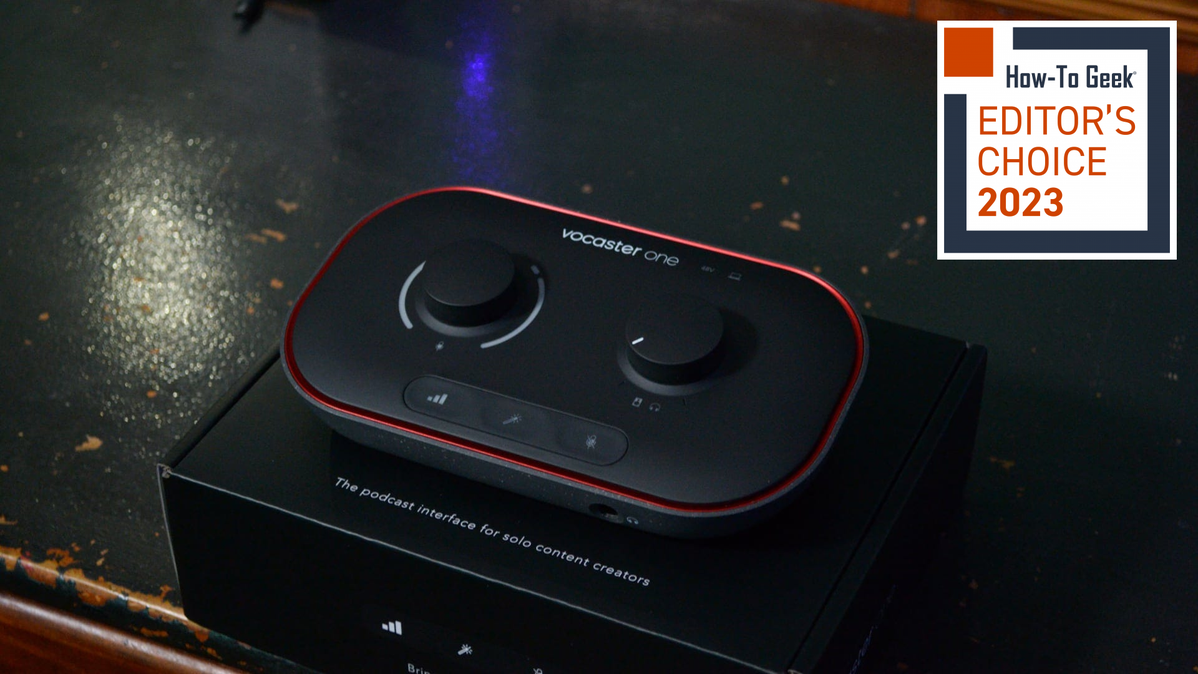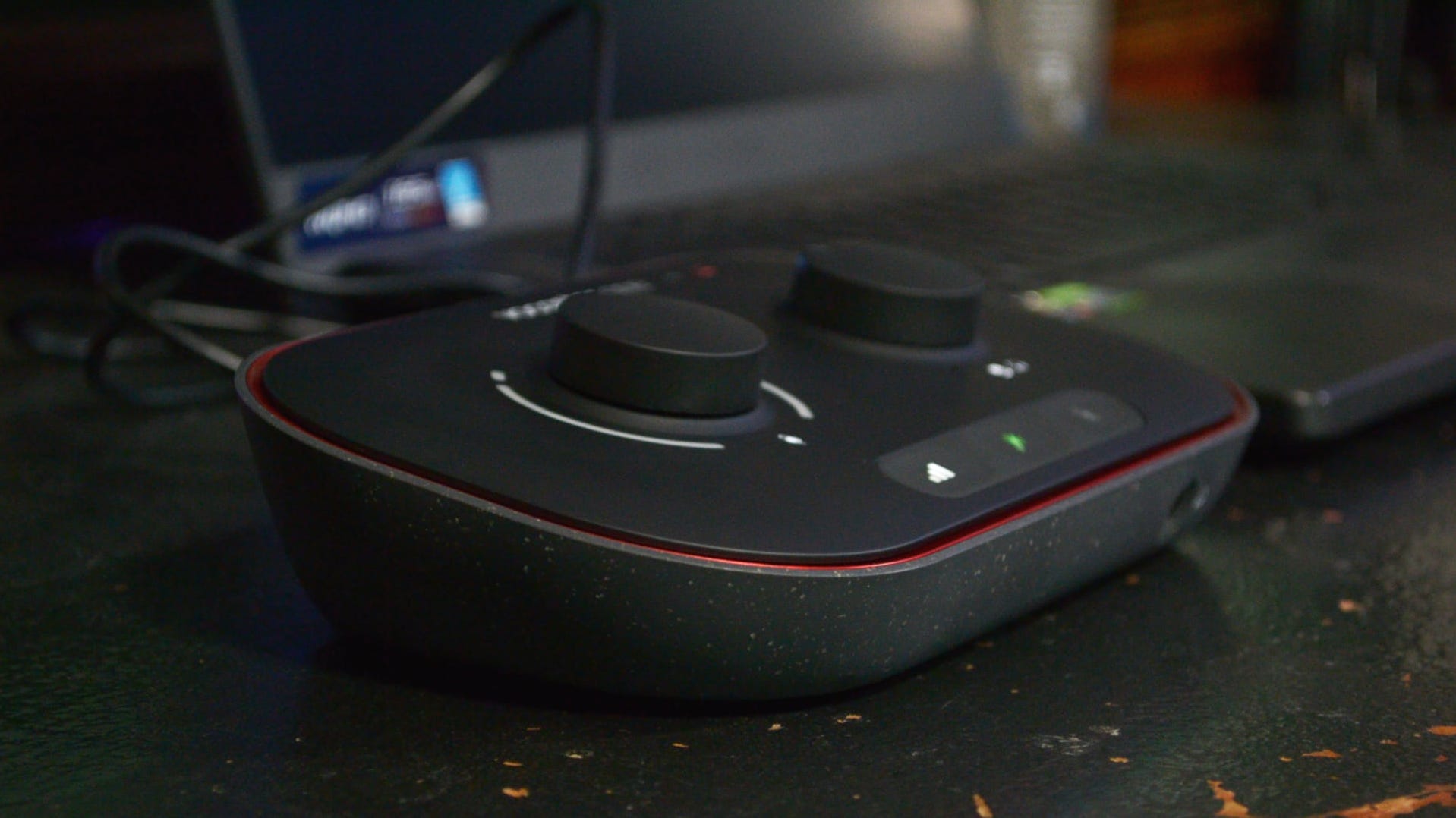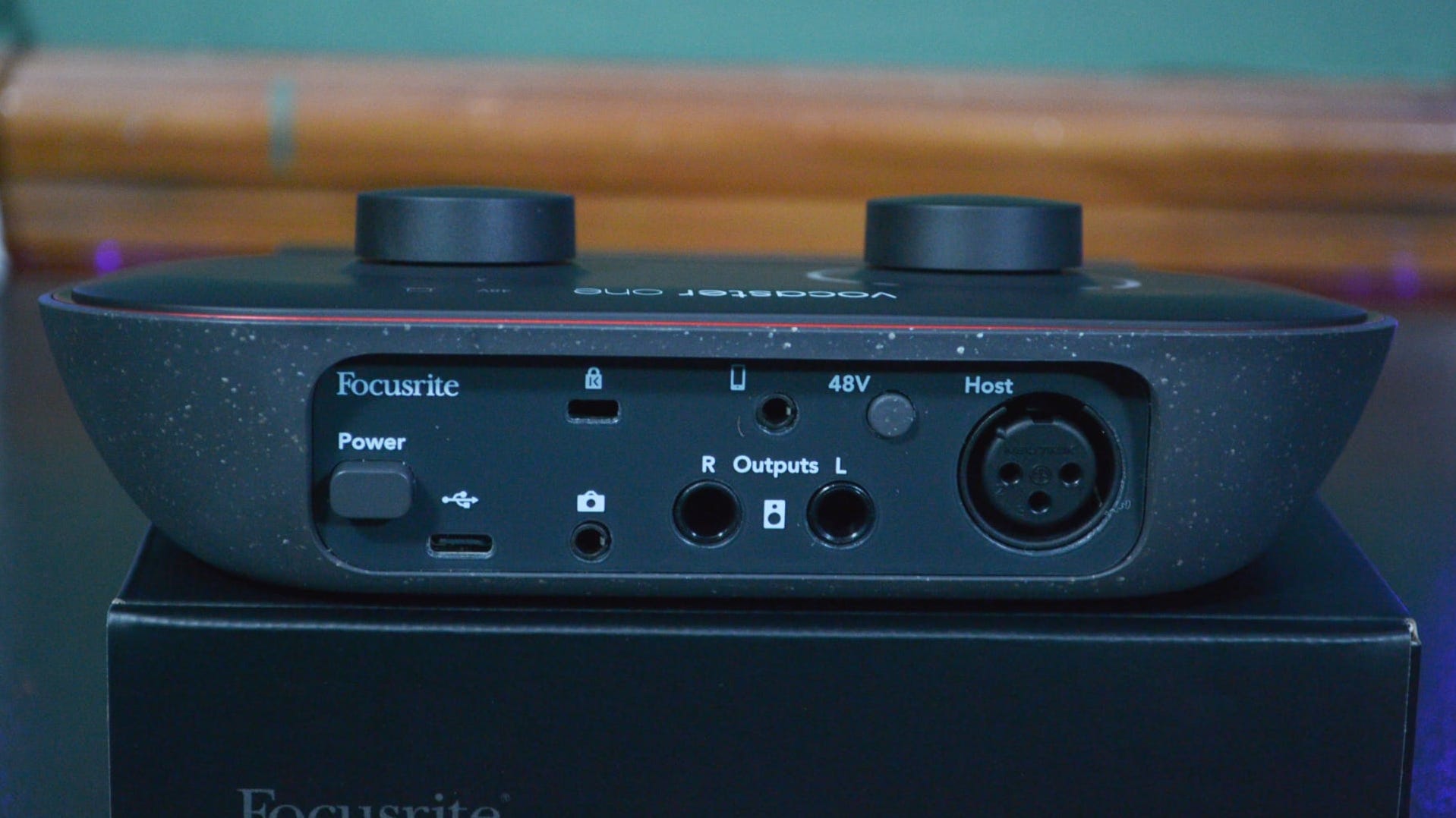
If you listen to podcasts, you’ve probably thought about starting one of your own. The problem is, most aren’t audio engineers, and it isn’t the easiest thing to pick up those skills. That’s where the Focusrite Vocaster One comes in, providing an all-in-one audio interface that anyone can use.
The Vocaster One is, as the name implies, a single-channel audio interface that includes everything you need to start podcasting or streaming, aside from a microphone and headphones. Focusrite does sell a bundle it calls the Vocaster One Studio, which includes a microphone, headphones, and all the cables you need. For this review, we’re focusing on just the interface.
Has Focusrite succeeded in making an interface simple enough for anyone to use, but powerful enough to be a serious production tool? Mostly, yes, but it depends heavily on what you’re looking to do.
Here’s What We Like
- Form factor makes it easy to carry and set up anywhere
- Plenty of gain on tap for both microphone preamp and headphone amp
- Hands-on controls give easy access for common options
- Easy to set up and use
- Multiple connectivity options make it great for podcasting
And What We Don’t
- Clearly not meant for music production
- Software bundle isn’t useful for everyone
How-To Geek’s expert reviewers go hands-on with each product we review. We put every piece of hardware through hours of testing in the real world and run them through benchmarks in our lab. We never accept payment to endorse or review a product and never aggregate other people’s reviews.
Getting Started With the Focusrite Vocaster One

While most audio interfaces aim to get audio signals into your computer for everything from broadcast to music, the Vocaster One is heavily focused on broadcast or, at the very least, the human voice. This means that it isn’t just good for podcasting, but also for video and streaming. Even the single XLR input here is labeled “host” instead of simply channel 1.
A single input doesn’t mean the Vocaster One is limited. We’ll look at the connectivity options in a bit, but between the interface and the included software, you can handle quite a bit. This includes single-person podcasts, shows with a host and remote guests, phone interviews, Zoom or Skype calls, and more.
The Vocaster One is lightweight and can be powered by your computer, with no need for an external power supply, though you can use an optional adapter (not included). Simply plug in the included USB cable, connect it to your computer, and download Focusrite’s Vocaster Hub app, available for Windows and macOS.
Once you launch the Vocaster Hub app, it walks you through the rest of the setup, including powering on your interface and updating the firmware.
Hardware and Connectivity

- Dimensions: 294.5 x 113 x 50.5mm (7.66 x 4.45 x 1.99in)
- Weight: 0.3481kg (0.77lbs)
- Power requirements: USB-3.0 Bus power 5V @900mA 4.5W
As mentioned above, the Focusrite Vocaster One is quite lightweight, but it still feels tough. Compared to other similarly priced interfaces, the Vocaster One feels lighter and more plasticky, but this is thanks to how Focusrite decided to build it, opting to use mostly recycled plastics for the case.
The main layout of the Vocaster is simple and easy to use. There are two continuous rotary knobs: one for volume and one for microphone gain. Then you have three buttons on the front: mute, Enhance, and Auto-Gain; as well as a button to enable 48-volt phantom power for the single input for XLR microphones for use with condenser microphones and other mics that require phantom power.
There are also a few backlit indicators on the Vocaster One: one to indicate you’re connected to the computer and one to show whether phantom power is enabled. When I first connected the Vocaster to my PC, the computer icon was red, showing a bad connection. It turned out the included USB-C to USB-A cable had issues. Switching to a different USB-C cable solved my problems.
In another indicator of how clearly the Vocaster is meant for voice and not music, the single XLR input is XLR only. Other interfaces often use combination jacks that also let you plug in a 1/4-inch instrument cable or pro audio jacks. The Vocaster doesn’t even bother with this.
While it may skimp on the XLR front, the Vocaster One includes some interesting connectivity options. A 3.5mm TRRS lets you loop in a phone call, bringing the caller’s voice into the interface and sending your audio back to the caller. Another 3.5mm TRS jack sends the audio mix out to a video camera, letting you easily sync sound and picture for videos.
The Vocaster One is a class-compliant USB interface, which means that it doesn’t need any special driver software to work with your computer. That said, the Vocaster Hub app and the other bundled software can make your podcasting life much easier.
Focusrite Vocaster Hub

The Vocaster Hub software functions as your main control. This is where you mix the various audio signals coming in, as well as where you can fine-tune the input gain of the microphone.
The Vocaster One features an Auto-Gain feature to set the perfect input level for your microphone automatically. Simply tap the Auto-Gain button and speak at your normal volume and distance from the microphone for 10 seconds. This will set the gain to the perfect level for your mic, not too quiet and not too loud.
You’ll also use the Vocaster Hub to fine-tune the Enhance modes. These are voice-enhancing EQ presets built into the Vocaster One. You can enable or disable enhancements on the device itself using the dedicated button, but you can choose between four modes: Clean, Warm, Bright, and Radio.



In addition to the microphone and TRRS inputs, you can also use the Vocaster Hub software to control the volume of the stereo loopback channels. This is a common feature in Focusrite interfaces, and lets you route any sound coming from your computer, from a YouTube video, for example, and route it through the interface.
You can use this to route audio from Zoom or Skype through the Vocaster, for example, but you can also use this in other fun ways.
Recording and Playback

- Bit depth: 24-bit
- Sample rate: 48kHz
Another of the many ways you can tell the Vocaster One is a podcast and video-specific interface is that it’s limited to 24-bit / 48kHz recordings. Many competing interfaces, including some in Focusrite’s own Scarlett range, offer sample rates up to 96kHz or even 192kHz. A 48kHz sample rate is fine for voice, and it’s the most-used sample rate for video, but this is clearly not an interface meant for musicians.
That said, Focusrite did not cheap out in designing the Vocaster One. For starters, there is plenty of preamp gain on tap. This is especially useful as broadcast mics like the Shure SM7b have very low output and need a strong preamp for adequate volume.
The onboard headphone amp also powered my Sennheiser HD650 headphones—known for not being the easiest to power—without breaking a sweat. Having a quality mix preamp and headphone amp in a single box is very useful, though again, the limited sample rate keeps it from being great for music listening.
You can choose how you wish to record, either recording the entire mix as a single track or breaking out the various channels. This allows you the flexibility to have the finished product immediately or have the flexibility for editing later.
Other Bundled Software

- Bundled software:
- Hindenburg LITE and 6-month Hindenburg PRO Trial
- aCast—6-month Influencer Plan
- SquadCast—3-month Pro + Video Trial
- Ampify Studio—6-month Premium Trial
To record audio on your computer, you need a digital audio workstation (DAW) for recording and mixing. Focusrite includes Hindenburg LITE as well as a six-month trial of Hindenburg PRO. Hindenburg is a DAW known for focusing on podcast and broadcast production rather than music production.
If you intend to have several remote guests, you’ll appreciate the three-month trial of SquadCast Pro + Video. This service makes it easy to gather and record audio from multiple remote guests, automatically taking care of issues like audio drift.
Similarly, you also get a six-month free trial of Acast’s Influencer tier. This service hosts your podcast and also distributes it across various services like iTunes and Spotify, along with other services.
Finally, the Vocaster One ships with six months of Ampify Studio Premium. This is an odd inclusion, as it’s more music-focused, but with more than 12,000 royalty-free sounds, it’s handy for any type of audio production.
Should You Buy the Focusrite Vocaster One?
The Focusrite Vocaster One offers a combination of ease of use, good sound quality, and handy features that are great for an aspiring podcaster or even a seasoned podcaster looking for a quick and easy setup. That said, if you’re looking for an interface for music production, turn to Focusrite’s Scarlett range or something like the Universal Audio Volt 2.
The 24-bit / 48kHz sound quality is all you need for a podcast, but it’s still slightly disappointing, as a higher sample rate would have made the Vocaster One great for listening to music in hi-res audio. The plasticky build quality is also worth pointing out, though here at least it’s thanks to Focusrite trying to be more environmentally friendly.
If you’re thinking about getting started podcasting, this is a perfect option unless you absolutely know you need something else. If you need something a little more, like for a podcast with two hosts or in-person interviews, consider the Vocaster Two, which doubles the inputs.
Rating: 8/10
Price: $160
Here’s What We Like
- Form factor makes it easy to carry and set up anywhere
- Plenty of gain on tap for both microphone preamp and headphone amp
- Hands-on controls give easy access for common options
- Easy to set up and use
- Multiple connectivity options make it great for podcasting
And What We Don’t
- Clearly not meant for music production
- Software bundle isn’t useful for everyone
